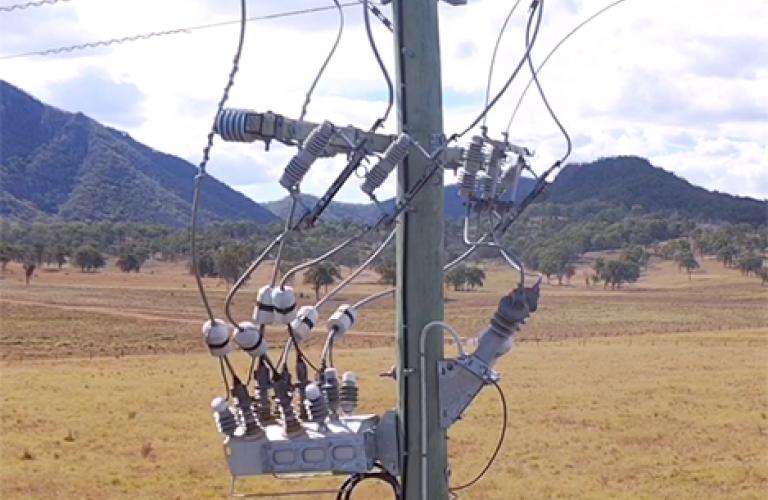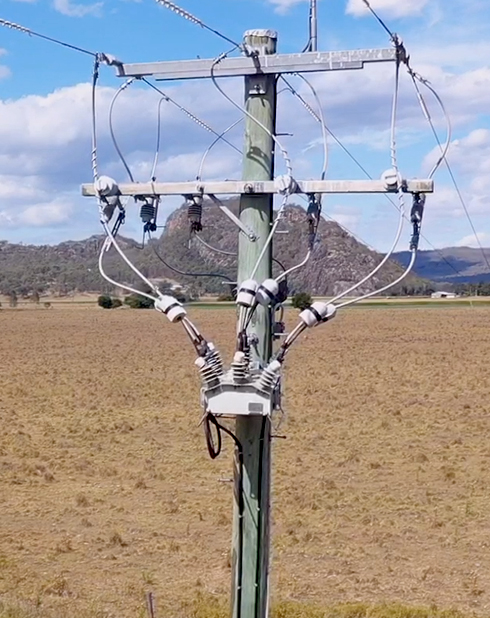#42 Marcela St., Damong Maliit, Brgy. Nagkaisang Nayon, Novaliches, Quezon City 1125, Metro Manila, Philippines

A combination of vast network size, low population densities and seasonal fire risk pose a unique set of challenges for engineers. However, this challenging distribution landscape provides exceptional opportunities for development of technology to provide solutions. Overhead distribution networks innately have more fire risk than underground reticulation, but there are academically published steps to follow to mitigate fire risk on the overhead network.
According to the research findings following the 2009 Victorian Bushfires, Reclosers have been deployed subsequently to mitigate risk. These reports indicated that reclosers capable of detecting a 500mA Sensitive Earth Fault would reduce fire start risk by 80% [1].
Achieving reliable and practical bushfire mitigation is the outcome of comprehensive bushfire mitigation policy. Most utilities in Australia develop a strategic policy which outlines the key risks and countermeasures to be put in place for fire risk mitigation. This policy covers key issues, including concepts such as:
To combat the risk profile presented by the harsh Australian summer, utilities have a range of technologies available to them on their Medium Voltage Distribution Network in the form of Switchgear, Protection and Control equipment to address these needs. When this technology is deployed as part of a well-designed bushfire mitigation policy, utilities can enjoy the benefits of a decreased bushfire risk and a safer summer, for both their employees and the broader public.
Managing Reclose Sequence
Throughout Australia, the utility workhorse for overhead line protection is the Automatic Circuit Recloser, or ACR. This device is essentially a Circuit Breaker with integrated sensors/transformers, with most modern devices being equipped with a semiconductor style control relay reminiscent of most substation relay offerings today.
Reclosers provide reliability on Distribution networks as they combat intermittent faults, by automatically reclosing circuit breakers under configured conditions, effectively removing the reliability issue of intermittent faults.
When bushfire mitigation policy is considered, industry recommendations from the 2009 Victorian Royal Commission into the Black Saturday Bushfires recommend that Reclosing be disabled on high bushfire risk days. This could be considered standard policy throughout Australia.
A jammed helical termination
(Source - Exhibit 525 - HRL Technology Report - Kilmore East Fire)
The major fire event at Kilmore South in Victoria was started by a SWER overhead line cable which had been dislodged from its saddle. When the cable eventually broke and landed on the grounded cable stay, the old Oil filled Hydraulic Recloser that was operating on this line did not have a modern controller or remote communications, meaning that it was left to Reclose and reenergise the line. It is highly important that all forms of reclosing is stopped on high bushfire risk days.
Furthermore, an emerging learning from research afterwards is that removing reclosing does not cover for high impedance faults such as floating insulator failure. If an insulator fails that arcing begins between the pole and the wire, a fire could be started without sufficient operating current being seen by older devices. The Victorian requirement is for sensitivity to 500mA Sensitive Earth Faults, something that Australian Switchgear Manufacturer NOJA Power has worked in conjunction with utilities to develop.
Recent proclaimed advances in reclosing technology advocate the use of partial/micro reclosing, where only a small proportion of energy is released, but the issue is that the devices are neither sufficiently sensitive to detect downstream high impedance faults, nor do they deliver sufficient energy to clear a fault when genuine reclosing is called for on low fire risk days.
Essentially, a partial reclose operation couldn’t detect a downstream sensitive earth fault compliant to Victorian Bushfire Mitigation Standards, providing no bushfire mitigation benefit.
The utility best practice for reclosers remains as disabling Reclosing on Bushfire Risk days, and instead focusing on better Protection methods and sensitivity to find these high impedance faults, and communications reliability to ensure that Reclosing can be reliably modified in the field. On low risk days, comprehensive reclosing provides the best reliability by delivering sufficient energy to clear intermittent faults.
Managing Communications Reliability
Controlling protection settings in remote devices on a distribution network is of paramount importance for bushfire mitigation. Whilst great improvements in communications reliability have been made in recent years, there are still features available in current ACR systems such as the NOJA Power Recloser that provide verification of communications
Reclosers deployed for bushfire mitigation should be coupled with a remote communications system, which in Australia typically deploys the DNP3 protocol over either an IP or radio network. Field ACR’s can then reasonably expect to periodically receive polls from the control room of the utility, as data is requested.
A simple technique that has been deployed for digitally controlled reclosers is a communications watchdog, a counter internal to the ACR that tracks the time since the last communication was received from the control room. If this exceeds a configured time-period, the controller resets the communications peripheral locally. This watchdog technique greatly improves reliability of communications in the field, and provides a technique to re-assert IP based communications with local cellular towers who typically service non-stationary clients. This is exhibited in the NOJA Power OSM Recloser range that was first installed throughout Victoria after the 2009 Bushfire event.
For risk-averse users, NOJA Power OSM Reclosers can be configured to default to a “Reclose Disabled” state when communication with a base station, providing a guarantee that reclosing best practice is deployed during high bushfire risk days.
Currently Deployed Protection Schemes
Developing protection sensitivity to high impedance faults has emerged as one of the key techniques to improving bushfire mitigation. High impedance faults have been suggested as a major cause of pole top fires, (such as through failed insulators), and improving detection of these cases improves responsiveness to bushfire risk cases.
A few commonly deployed protection schemes are listed below:
These protection features are equipped in the high-resolution sensor variant of the NOJA Power OSM Recloser, along with further developments as NOJA Power partners with Australian utilities to continue development in this area of research.
“Bush fire risk is one of the greatest challenges the Australian distribution network service providers face. Deploying reclosers on rural feeders with remote control combined with low level SEF and admittance protection allows DNSPs to manage this risk,” says NOJA Power Group Managing Director Neil O’Sullivan.
Managing Automation
Distribution Automation provides significant reliability advantage on distribution networks, offering fault location, isolation and restoration facilities. The economic benefits of such a system is clear, but during fire risk days, network automation should be carefully monitored to ensure that no re-energisation of possible fault sites are executed.
Communications and visibility of the full distribution network is of paramount importance when considering bushfire mitigation, and a reliable control system will provide this capability. Once reliable communications are achieved, it is possible to centralise automation operations and allow the control room to execute automation, rather than older distributed automation techniques which use voltage presence as a cue for reclosing.
When paired with detection techniques such as Voltage Sag, NOJA Power OSM Recloser provide additional field insights to the control system and allow utilities to make better switching decisions on bushfire risk days. The added resolution of sensing and reporting also provides the capacity to identify problem sites sooner, helping support a rapid response to any risk sites.
Conclusion
Bushfire Mitigation strategy is the result of a coordinated approach to address bushfire risk factors. For Overhead Distribution networks, protection and control is required. NOJA Power Switchgear has collaborated with Australian utilities to develop a suite of bushfire mitigation techniques to address the requirements of the Australian DNSP environment.
When it comes to Reclosing, whilst all forms of reclosing should be disabled, but the key is protection sensitivity to high impedance faults. On low fire risk days, traditional reclosing should be applied to provide sufficient energy to clear intermittent faults.
Communications Reliability is essential for providing control of the Reclosing Sequence and applied protection settings during bushfire risk days. NOJA Power’s OSM Recloser system has integrated systems to support communications reliability, and a further capacity to default to a safe mode operation when communications are lost.
The reliability of communications from a NOJA Power OSM Recloser system can be used for the further monitoring, control and centralised automation of the network, allowing signals such as Voltage Sag and other specialist indications from the OSM Recloser to be used to improve sensitivity and reactivity to fault scenarios on bushfire risk conditions.
NOJA Power is committed to working with Australian utilities to provide the best quality of overhead switchgear, but also in partnership to develop world leading protection functionality to keep Australians such as NOJA Power safe at home during bushfire season. To learn more or for support in developing your bushfire mitigation strategy, NOJA Power would be pleased to share the learned expertise and capability of the Australian bushfire mitigation strategy experience. Get in contact at www.nojapower.com.au
References:

NOJA Power OSM Relcoser Installation